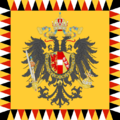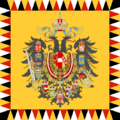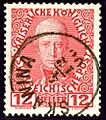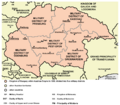Austrian Empire facts for kids
Quick facts for kids
Empire of Austria
Kaisertum Österreich (German)
|
|||||||||||||||||||||||||||||||
|---|---|---|---|---|---|---|---|---|---|---|---|---|---|---|---|---|---|---|---|---|---|---|---|---|---|---|---|---|---|---|---|
| 1804–1867 | |||||||||||||||||||||||||||||||
|
Anthem: Gott erhalte Franz den Kaiser
("God Save Emperor Francis") |
|||||||||||||||||||||||||||||||
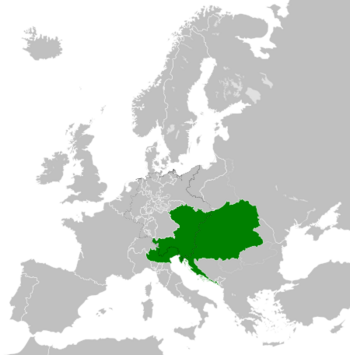
The Austrian Empire in 1815, with the boundaries of the German Confederation in dotted lines
|
|||||||||||||||||||||||||||||||
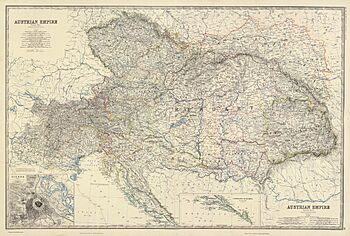
Greatest extent of the Austrian Empire
(1846–1859) |
|||||||||||||||||||||||||||||||
| Capital | Vienna | ||||||||||||||||||||||||||||||
| Common languages | German, Hungarian, Czech, Slovak, Polish, Ruthenian, Slovene, Croatian, Serbian, Romanian, Istro-Romanian, Lombard, Venetian, Istriot, Friulian, Ladin, Italian, Ukrainian, Yiddish | ||||||||||||||||||||||||||||||
| Religion | Majority: Roman Catholic (official) Minorities: Lutheranism, Calvinist, Eastern Orthodox, Eastern Catholic, Judaism |
||||||||||||||||||||||||||||||
| Demonym(s) | Austrian | ||||||||||||||||||||||||||||||
| Government |
|
||||||||||||||||||||||||||||||
| Emperor | |||||||||||||||||||||||||||||||
|
• 1804–1835
|
Francis I | ||||||||||||||||||||||||||||||
|
• 1835–1848
|
Ferdinand I | ||||||||||||||||||||||||||||||
|
• 1848–1916
|
Franz Joseph I | ||||||||||||||||||||||||||||||
| Minister-President | |||||||||||||||||||||||||||||||
|
• 1821–1848
|
Klemens von Metternich (first) | ||||||||||||||||||||||||||||||
|
• 1867
|
Friedrich Ferdinand von Beust (last) | ||||||||||||||||||||||||||||||
| Legislature | Imperial Council | ||||||||||||||||||||||||||||||
| House of Lords | |||||||||||||||||||||||||||||||
| House of Deputies | |||||||||||||||||||||||||||||||
| Historical era | 19th century | ||||||||||||||||||||||||||||||
|
• Proclamation
|
11 August 1804 | ||||||||||||||||||||||||||||||
| 6 August 1806 | |||||||||||||||||||||||||||||||
| 8 June 1815 | |||||||||||||||||||||||||||||||
| 13 March 1848 | |||||||||||||||||||||||||||||||
|
• Constitution adopted
|
20 October 1860 | ||||||||||||||||||||||||||||||
| 14 June 1866 | |||||||||||||||||||||||||||||||
| 30 March 1867 | |||||||||||||||||||||||||||||||
| Area | |||||||||||||||||||||||||||||||
|
• Total
|
698,700 km2 (269,800 sq mi) | ||||||||||||||||||||||||||||||
| Population | |||||||||||||||||||||||||||||||
|
• 1843 estimate
|
37,500,000 | ||||||||||||||||||||||||||||||
| Currency |
|
||||||||||||||||||||||||||||||
|
|||||||||||||||||||||||||||||||
|
1: Territories of Austria and Bohemia only.
|
|||||||||||||||||||||||||||||||
The Austrian Empire was a very important and large country in Europe from 1804 to 1867. It was created by the Habsburg monarchy, a powerful family that ruled many lands. This empire was a "multinational state," meaning it included many different groups of people and cultures.
At its peak, the Austrian Empire was one of the biggest countries in Europe. It had the third-largest population and was the third-largest in size, after the Russian and French Empires.
Emperor Francis II started the Austrian Empire in 1804. He did this because Napoleon had just declared himself Emperor of France. Francis wanted to make sure his family's lands stayed strong and united. The empire fought against Napoleon in the Napoleonic Wars. After these wars, the Congress of Vienna in 1815 confirmed Austria as a major power in Europe.
The Kingdom of Hungary was a special part of the empire. It had its own government and rules. Later, after a war in 1866, the Austrian Empire and the Kingdom of Hungary joined together to form Austria-Hungary in 1867.
Contents
How the Austrian Empire Began
The Holy Roman Empire was a very old and complicated group of states in Central Europe. By the early 1800s, it was changing a lot. Napoleon, the powerful French leader, was creating his own empire.
In 1804, Francis II, who was the Holy Roman Emperor, decided to create a new title for himself: Emperor of Austria. He did this to protect his family's power and lands. He knew the old Holy Roman Empire might soon end, and he didn't want Napoleon to take over that title. So, Francis became Francis I of Austria.
This new Austrian Empire brought together all the lands that the Habsburg family already ruled. Before, these lands were like separate countries connected only by having the same ruler. Now, they were officially part of one big state. However, some parts, like the Kingdom of Hungary, still kept many of their own rules and governments.
Napoleon's armies defeated Austria in battles like Ulm and Austerlitz in 1805. This led to a peace treaty that made Austria give up some land. Because of Napoleon's growing power, Francis I officially ended the Holy Roman Empire in 1806. He didn't want Napoleon to become its new emperor.
The Age of Metternich: A Powerful Statesman
From 1815 to 1848, a very important person named Klemens von Metternich guided the Austrian Empire. He was the Foreign Minister and later the Chancellor of State. This time is often called the "Age of Metternich" because he had so much influence.
Metternich believed in strong, traditional governments, like absolute monarchy. He was against new ideas like liberalism and revolutions. He worked hard to keep the Habsburg family in power and to maintain peace in Europe.
After the Napoleonic Wars, Metternich was a key leader at the Congress of Vienna in 1815. This meeting helped redraw the map of Europe and set up alliances. Austria gained new lands and became a leading member of the German Confederation. Metternich also organized other meetings, sometimes called "Metternich congresses," to solve problems between European countries peacefully.
To keep things stable at home, Metternich used strict rules. He censored books and newspapers and used a network of spies. He wanted to stop any ideas that might lead to rebellion.
Emperor Francis I trusted Metternich a lot. But after Francis I passed away in 1835, Metternich's power slowly lessened. The new emperor, Ferdinand I, had health issues and wasn't able to rule alone. A council, including Metternich, helped govern.
The Metternich era was a time of peace and economic growth for the Austrian Empire. The population grew, and cities like Vienna became larger. However, the desire for more freedom and national identity was growing, and this would eventually lead to big changes.
The Revolutions of 1848
In 1848, big changes swept across Europe, and the Austrian Empire was no exception. Many people, especially young students and workers, wanted more freedom and a say in their government. Different groups also wanted their own nations to be recognized.
These movements, called the Revolutions of 1848 in the Austrian Empire, challenged the old ways. People protested against strict rules and demanded new rights. Even though many of these revolutions didn't fully succeed, they brought important changes. For example, serfdom (a system where peasants were tied to the land) was ended, and censorship was stopped. Emperor Ferdinand I of Austria also promised to create a constitution for the empire.
The Bach Era: Centralizing Power
After the revolutions, a new leader named Baron Alexander von Bach became very influential. He was the Minister of the Interior and worked to make the Austrian Empire more centralized. This meant that the government in Vienna had more control over all the different regions.
Bach's policies were quite strict. He limited freedom of the press and made it harder for people to speak freely. He also gave the Roman Catholic Church more power over schools and family matters. This time is sometimes called "neo-absolutism" because it brought back some of the old, absolute ways of ruling.
Despite these strict political controls, Bach also made some economic improvements. He removed internal taxes between regions, which helped trade. Peasants, who were once tied to the land, gained more freedom.
During this time, Austria also faced challenges from other countries. It lost some territory in Italy after a war in 1859.
The End of the Empire and Birth of Austria-Hungary
Even with new constitutions, many groups within the Austrian Empire were still unhappy. They wanted more self-rule and recognition for their own cultures and languages.
After another war in 1864, Austria gained control of some new lands. However, internal problems continued to grow. The Hungarians, in particular, pushed very hard for more independence.
A major turning point came in 1866 when the Austrian army was defeated in the Austro-Prussian War. This loss led to big changes. In 1867, the Austro-Hungarian Compromise of 1867 was signed. This agreement transformed the Austrian Empire into Austria-Hungary. It created a "Dual Monarchy," where Austria and Hungary became two equal parts under one ruler.
Austria's Role in European Politics
The Austrian Empire played a huge role in European politics, especially during and after the Napoleonic Wars. Its army was very strong, and it often found itself fighting against Napoleon's France. These wars were very expensive and challenging for Austria.
After Napoleon's defeat, Klemens von Metternich became the main architect of Austria's foreign policy. He worked hard to keep peace and balance among the European powers. He wanted to prevent new wars and revolutions.
Metternich's diplomacy helped Austria become a leading country in Europe. He made sure Austria had good relationships with other powerful nations like Britain, Prussia, and Russia. He also tried to keep a balance of power in the German Confederation, where Austria was a key member.
Later, Austria faced new challenges. During the Crimean War, Austria chose to stay neutral, which made it lose some allies. This isolation hurt Austria's position in Europe. It lost influence in Italy after a war in 1859 and then in German-speaking lands after the Austro-Prussian War in 1866. These events showed how much European politics were changing.
Many Lands and Peoples
The Austrian Empire was like a patchwork quilt of many different lands and regions. It included parts of what are now Austria, Hungary, Czech Republic, Slovakia, Poland, Ukraine, Romania, Croatia, Slovenia, Italy, and more!
Each of these lands had its own history and often its own local customs and languages. Some of the main parts included:
- The original lands of Austria
- The Kingdom of Bohemia (today's Czech Republic)
- The Kingdom of Hungary
- Galicia (part of today's Poland and Ukraine)
- Lombardy-Venetia (parts of northern Italy)
This mix of regions meant the empire was home to many different ethnic groups, like Germans, Hungarians, Czechs, Poles, Croats, Serbs, Romanians, and Italians. Managing all these different groups and their desires for self-rule was a constant challenge for the emperors.
Education in the Empire
In the Austrian Empire, German was the main language used in universities and for higher education. This was important because it helped unite the different parts of the empire, but it also meant that students from other language groups had to learn German to get a higher education.
The Austrian Army
The Austrian Empire had a large and powerful army, known as the Imperial Austrian Army. It played a crucial role in defending the empire and fighting in major European conflicts, especially during the Napoleonic Wars.
Economy and Trade
The Austrian Empire's economy faced challenges, especially after the expensive Napoleonic Wars. However, during the "Age of Metternich," the economy grew steadily.
Trade was important, though not as large as in countries like France or Great Britain. The empire worked to improve its finances and collect taxes, with land taxes being a major source of income. Removing internal customs duties also helped boost trade within the empire.
People of the Austrian Empire
The Austrian Empire was home to many different groups of people, making it a truly diverse place. This included:
- Germans
- Hungarians
- Various Slavic peoples (like Czechs, Poles, Croats, Serbs, and Slovaks)
- Romanians
- Italians
In the mid-1800s, the empire had a population of around 35 to 37 million people. This mix of cultures and languages was one of the empire's defining features, but it also led to challenges as different groups sought more recognition and rights. During the Revolutions of 1848 in the Austrian Empire, some minority groups even supported the emperor against other rebellious groups, hoping for better treatment.
Images for kids
-
The Declaration of Victory After the Battle of Leipzig, showing leaders after the Battle of Leipzig, 1813.
-
Diplomats at the Congress of Vienna, 1815, including Klemens von Metternich.
See also
 In Spanish: Imperio austríaco para niños
In Spanish: Imperio austríaco para niños
- Former countries in Europe after 1815
- Austria-Hungary
- Cisleithania for the Austrian Empire after the Austro-Hungarian Compromise of 1867




